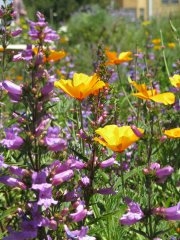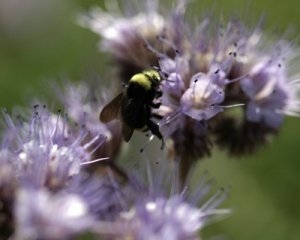Client's Request: Can you give me some help on locating bee-friendly plants that are extremely drought tolerant (we have typical clay soil with a thin cover of mulch)—Thanks
There are a variety of bee-friendly plants that are drought-tolerant.
To get started, the University of California's Urban Bee Lab has a list of best bee plants for California: http://www.helpabee.org/best-bee-plants-for-california.html. Most of the plants listed are drought-tolerant. In general, they note if additional water is required.
Further information is available from the California Native Plant Society (CNPS). It has a good article on establishing a bee-friendly garden: http://grownatives.cnps.org/2013/03/25/to-bee-or-not-to-bee/. The article provides a starter list of plants plus advice on the characteristics of a good bee-friendly garden with emphasis on growing a variety of plants in terms of size, shape, and colors and differing blooming periods. Advantages of native plants is that they are typically drought-tolerant and many are adapted to clay soils.
You can also use the Sunset Western Garden book sfor descriptions of many of the plants on both lists. CNPS also has a database of natives that you can use for reference: http://calscape.cnps.org/. 
Keep in mind that drought-tolerant plants are best planted in the fall so that they can take advantage of the fall and winter rains. So, now is a good time to plan your garden. I usually start looking and buying native plants now while the selection is often greater and then care for them in their containers awaiting fall planting. Also, keep in mind that even drought-tolerant plants will require water for the first several years to get established.
Good luck with your bee-friendly drought-tolerant garden. Please feel free to get back to us if you have further questions.
Note: Both pictures above aref from the Bringing Back the Natives 2015 Tour in the Bay Area. there are many pictures of bee garden on their web site that should give you plenty of ideas about planning and planting a bee garden.
Help Desk of the Master Gardeners of Contra Costa County
Note: The Master Gardeners of Contra Costa's Help Desk is available year-round to answer your gardening questions. Except for a few holidays, we're open every week, Monday through Thursday for walk-ins from 9:00 am to Noon at 75 Santa Barbara Road, 2d Floor, Pleasant Hill, CA 94523. We can also be reached via telephone: (925) 646-6586, email: ccmg@ucanr.edu, or on the web at http://ccmg.ucanr.edu/Ask_Us/